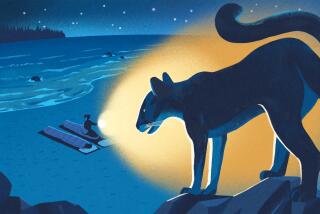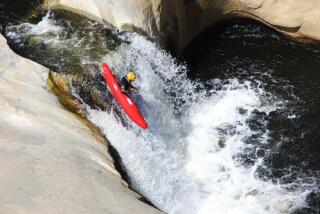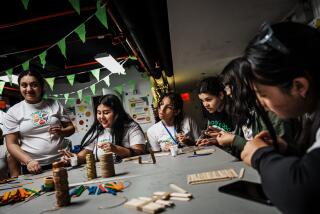White-Knuckle Adventure
- Share via
I had gone to Africa to be on the banks of the Zambezi River to watch my daughter navigate the thundering maelstrom in a rubber raft.
But the story of our recent odyssey down the waterway that David Livingston described in 1853 as “God’s Highway” became a roller coaster ride ranging from an idle paddle through the unspoiled reaches of Zimbabwe, to the horror of watching two beautiful young women frantically swim for their lives.
The madcap safari actually began in Northern California, where my daughter has worked as a river guide for the past four summers. At 24, Juliet is a recent UC Berkeley graduate who thrives in the tightknit world of river guiding, a subculture that places a very high value on community and nature, good food, cheap travel and huge water.
She’s always broke. Still, she’s managed to travel from Placerville to Patagonia and has friends everywhere. Her rusted-out old Toyota could break down on an obscure road in Newfoundland, and she undoubtedly would know someone in the neighborhood to call.
Normally a good-natured, sensible young woman, she is easily irritated and occasionally a little defensive when people ask her when she’s going to get a real job.
“My definition of hell is commuting on a freeway to an office,” she says. “I have a job. I love what I do,” she says brightly.
Her brother, a confirmed urban dweller, who, until recently, did not own a pair of tennis shoes, cannot fathom how his little sister could have became such a Nature Woman. He worries about her.
Me too.
*
It was last spring that Juliet paddled her way through a national competition to qualify for a spot as one of the six members of the U.S. women’s team who would participate in the 1997 Camel Whitewater Challenge and Rafting World Championship. The event is held annually in the steep, serpentine gorge just downstream from Victoria Falls, “the smoke that thunders.”
Juliet and Brooke Winger, a champion kayaker and president’s scholar at Cal State Long Beach, were the team cubs, the youngest members by far. Brooke is 20. The other four women, all incredibly strong, gutsy Californians in their mid-30s to 40, are among the best-known white-water rafters--anywhere.
Among them, they have a couple of boyfriends, a fiance, two dogs, two houses, a sailboat, an ambiguity about motherhood, an abiding respect for nature and the kind of unwavering confidence that comes with accomplishment and living on the edge.
All are low-maintenance, nonfrivolous women with arms and legs of steel who have spent more time in tents than hotels. “They’re pretty gnarly,” Juliet said with some trepidation after her first practice with them.
Though Juliet is a athlete, she gravitates more to running a children’s summer river camp than to conquering furious waterways. I work at a desk and do not use a StairMaster or frequent a gym. Though I prefer offbeat travel to luxury spas, I’m scared of everything--freeways, airplanes, heights, chairlifts, rodents, reptiles and rivers in which paddlers are required to wear helmets for their safety.
On the day I arrived in Zimbabwe, I met Juliet and her teammates at their hotel. They’d arrived a week earlier to practice on the Zambezi River. As they returned from the rim of the gorge, it was clear they had not had a good day.
They had come in dead last in the sprint out of 21 teams. Juliet had been acutely sick two days before. The next day was the slalom, followed by the down-river race on Day Four.
The Whitewater Challenge attracts well-trained teams from countries ranging from Mexico to Israel, Canada to the Czech Republic. Rafting this section of the river is something like plunging into an industrial-sized washing machine on the extra rinse cycle. It is a cathedral of huge water that pounds down a series of 24 monster rapids with names like Commercial Suicide and the Gnashing Jaws of Death.
*
The night before the slalom, Juliet reminded me that the Zambezi looks a lot more dangerous than it is. She pointed out that its depth and high volume make it one of the safest big rivers to paddle. She also pointed out that the 750-foot descent into the gorge is considerably steeper than I had been told, and that I would need to borrow a helmet.
“A helmet?”
“You can only get to the racecourse by raft. You can do it,” she said firmly. “I’ve got to go to bed, Mom. I can’t be worried about you. You’ll be fine. You can do it.” (The refrain had a maddeningly familiar ring.)
The trek into the gorge isn’t just steep. It involves a series of heart-stopping acrobatics such as climbing on primitive ladders fashioned out of tree branches and twigs, and scaling a cliff that drops into a caldron of sharp boulders and death-defying whirlpools.
(Juliet says I exaggerate. I remind her that one race official had a panic attack on one cliff and had to be helicoptered out.)
Had it not been for the encouragement and kindness of two rafting coaches from Slovakia, I wouldn’t have attempted it, much less survived. With their strong arms and encouraging words, I somehow managed to make it to river’s edge to embark on the next obstacle.
The term “go with the flow” took on new meaning. But the water on the first rapid, Overland Truck Eater, was, astonishingly, not the suction cup from hell I had imagined. In fact, I not only made it to the slalom course drenched and laughing, I became so intoxicated with my amazing physical prowess and emotional stamina, it didn’t occur to me to worry about Juliet and her teammates.
The American women’s team was the first to paddle the slalom course. From my rocky perch, I watched them successfully navigate the first gate. What I saw was stunning. Far from being a floating catastrophe they had privately feared, they were a powerful, graceful union of women who paddled as one.
Other teams followed. Flips. Wipeouts. Carnage. By the time the eighth boat had completed the run, the U.S. women’s team was still in the lead.
On the second run, they did it again. Two days later on the down-river course, they directed their raft in a perfect line. They scored the highest number of overall points in the women’s category over veteran women’s teams from Canada and England, and also beat the men’s team from Kazakhstan.
They had not only rallied. They had won the gold.
At the awards ceremony two nights later, lights glowed and cameras whirred. As gold medals were placed around their necks, the U.S. women’s team was given a standing ovation. Baboons barked in the distance. Wart hogs nibbled on the hotel lawn. I stood in awe, and cried.
*
It was against this backdrop that I joined Juliet and five other rafters for a celebratory canoe safari on the middle Zambezi River in Mana Pools National Park, an unadulterated wilderness area designated by UNESCO as a World Heritage Site.
It took two airplane rides and a four-hour trek by land cruiser to get there. Our veteran guide, Gary Wingate, talked about camping etiquette, paddling and perils. The talk centered on what to do in the event of an attack from a Cape buffalo, a crocodile or a hippopotamus.
This was clearly not going to be an idle glide through the floating pink water hyacinths.
Then he issued this warning: Hippos kill more humans than any other wild animal in Africa. In the unlikely event one of our five fiberglass canoes was attacked, he emphasized that we should swim away from the canoe. Fast. “Hippos are known to go after canoes.”
He emphasized that hippos aren’t just docile water slugs with fat bodies and weird little pink ears. They weigh 2 tons. They can be ferocious killing machines capable of traveling at tremendous speeds.
No one said a word. Gary made an attempt at bush humor by assuring us that he always carries hippo repellent.
Hippo repellent? He reached into a dry bag and pulled out a Colt .45.
For the next two days we would paddle through some of Africa’s wildest regions, camping at night on sandy beaches touched only by footprints of hippos and crocs, lions and hyenas.
Juliet and I slept fitfully, ever wary of the cacophony of grunts and barks, hollers and roars just beyond our tent. But it was the hippos that really drove us nuts. The river was crawling with them--hundreds of them. They’d pop up, blow and grunt, and stealthily submerge near our canoes like enemy submarines.
*
Gary warned us that on Day Three of our four-day safari, we’d be paddling through a section of narrow channels known as Hippo City. He had us vote on our river route: Hippo Boulevard or Hippo Bronx. I was outvoted. We headed for Hippo Bronx.
As we paddled deeper into Hippo City limits, we were surrounded by a creepy stew of hippos. There were pods on each side of our canoes. As we rounded one curve, we noticed two vanish below our five-boat flotilla. No one said a word.
About 200 yards later we heard the terrible sound.
“Boom.”
I swung around from my seat at the bow of the lead canoe. Our third canoe was overturned. Its inhabitants were in the water swimming frantically. The sight was horrifying. The swimmers had about 30 feet to go to get to the bank.
One of them was Juliet.
By the time Gary paddled our canoe to the bank and I leaped out, Brooke was just getting to shore. Juliet was still in the water, a few more strokes. . . .
She finally propelled herself out of the water. She had all of her limbs and toes. She could walk. She was terrified, but she was safe.
Their faces contorted in horror, she and Brooke alternately shivered and sobbed: I saw his face. He was right there. We were in the water. . . . I didn’t know where he was. . . . Terrible. He was right there! Oh, Mom, it was so awful.
I knew only to hold them very tight. I didn’t want to let them go, but knew I must. Everyone was strangely quiet. This was no time to fall apart, and we all knew it. We were still deep inside Hippo City. There was gear to salvage, a gaping hole in Brooke and Juliet’s canoe to patch.
Juliet announced emphatically, “I’m ready to go home now.”
*
We are home now. One of these days we hope to rendezvous with the remarkable women on the trip for our first World Championship Reunion and Hippo Support Group. We look forward to swapping pictures and stories, and to getting the scoop on teammate Julie Munger’s plans to return to Africa to be with Gary--canoe safari Gary.
It was a journey that changed our perspectives, as every good journey must. We didn’t come home with light and easy spirits. What we did come home with is a renewed respect for the forces of nature--and for one another.
Last night I shared some of the highs and lows of the trip with a friend.
“Please remind me,” I asked him. “Why did I go to Africa?”
“Because you are a human being and a parent,” he said. “Parents show up.”
More to Read
Sign up for The Wild
We’ll help you find the best places to hike, bike and run, as well as the perfect silent spots for meditation and yoga.
You may occasionally receive promotional content from the Los Angeles Times.






